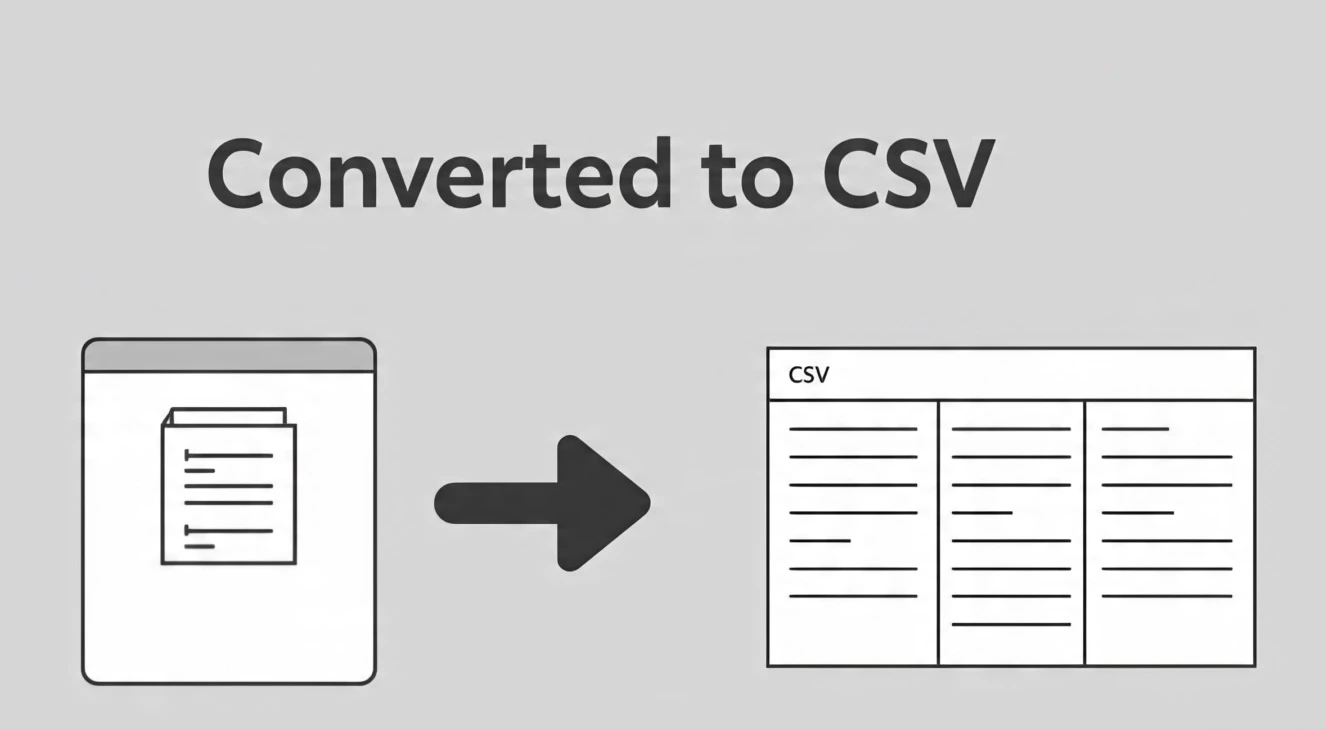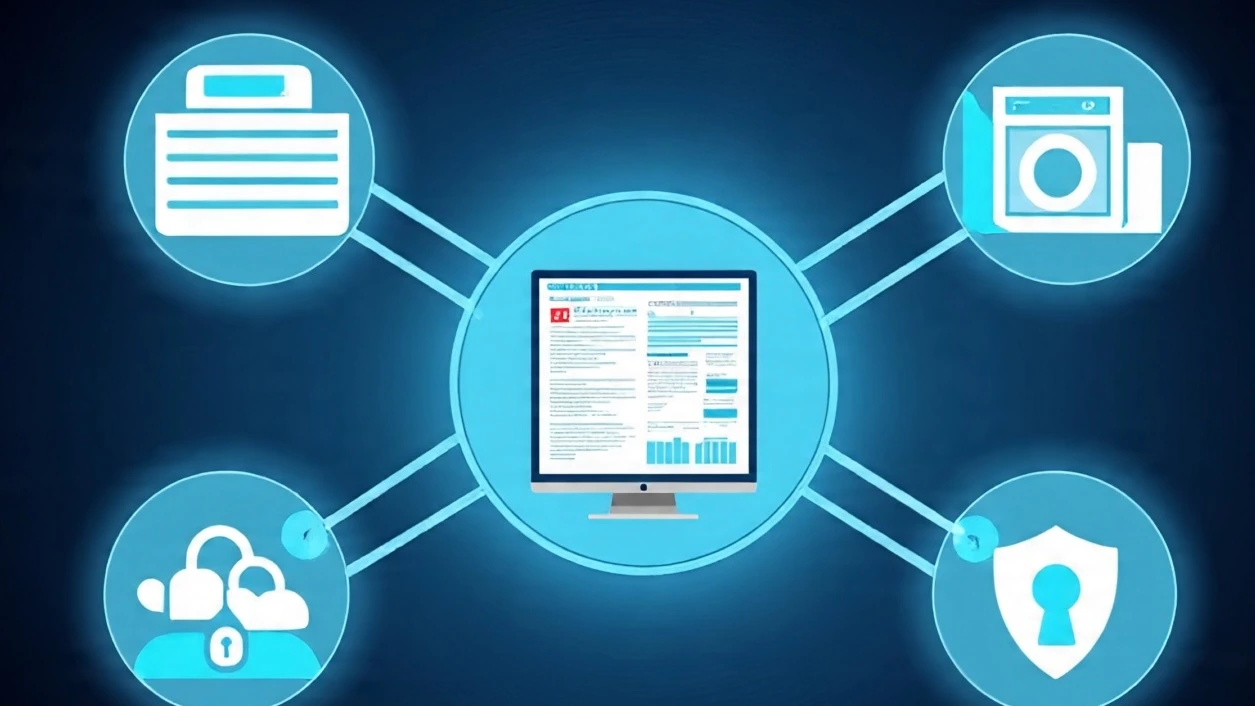
PDF to CSV Converter: Complete Guide for Data Extraction in 2025
PDF to CSV Converter: Complete Guide for Data Extraction in 2025
You know that feeling when you have a PDF full of important data, but it might as well be written in stone tablets? Yeah, I've been there too many times to count. You can see the numbers, you can see the patterns, but actually *working* with that information? Forget about it.
That's where CSV files become your best friend. Think of CSV as the universal translator of the data world—every spreadsheet program, database, and analytics tool speaks fluent CSV. I'm going to show you exactly how to break your data free from those PDF prisons and get it into a format where you can actually do something useful with it.
Why PDFs Drive Us Crazy (And Why CSV Is the Answer)
Let me paint you a picture. Last month, I needed to analyze sales data from a quarterly report. Beautiful PDF, looked professional, had all the numbers I needed. But when I tried to sort the data or create a quick chart? Nope. It was like trying to rearrange furniture that's been glued to the floor.
Here's What Makes PDFs So Frustrating:
- They're Made for Looking, Not Doing: PDFs are basically digital paper. Great for reading, terrible for actually working with the data inside.
- Every PDF Is a Special Snowflake: Tables, weird fonts, images mixed with text—each PDF seems designed to make data extraction as difficult as possible.
- You Need Special Tools: Want to edit something? Hope you have the right software and it's feeling cooperative today.
- Finding Stuff Is a Nightmare: Try searching for specific data patterns in a 50-page PDF. I'll wait.
CSV Files? They're Data Liberation:
- Everything Speaks CSV: Excel, Google Sheets, your database, that analytics tool you love—they all treat CSV like a native language.
- Tiny and Fast: CSV files are lean and mean. No bloated formatting, just pure data that loads and processes lightning-fast.
- Plug and Play: Import into any tool, manipulate however you want, export wherever you need. It just works.
- Math Friendly: Want to sort, filter, calculate, visualize? CSV data is ready for action the moment you open it.
Types of PDFs and Conversion Challenges
Understanding your PDF type is crucial for choosing the right conversion approach:
Text-Based PDFs:
- Native Text PDFs: Created digitally with selectable text - easiest to convert
- Structured Tables: Well-formatted data in clear rows and columns
- Mixed Content: Combination of text, tables, and other elements
Image-Based PDFs:
- Scanned Documents: Require OCR (Optical Character Recognition) technology
- Image Tables: Charts and graphs that need specialized extraction
- Poor Quality Scans: May require preprocessing for better results
Method 1: Online PDF to CSV Converters
Online converters offer convenience and accessibility for quick conversion tasks without software installation.
Top Online Conversion Services:
Free Online Tools:
- Tabula: Open-source tool specifically designed for PDF table extraction
- ILovePDF: User-friendly interface with batch processing capabilities
- SmallPDF: Reliable conversion with basic editing features
- PDF24: German-based service with strong privacy focus
Premium Services:
- Adobe Acrobat Online: Industry-standard with advanced OCR capabilities
- Nitro PDF: Business-focused with collaboration features
- PDFelement: Comprehensive PDF management suite
Step-by-Step Online Conversion Process:
- Select a Converter: Choose based on your security and feature requirements
- Upload PDF File: Drag and drop or browse to select your document
- Configure Settings: Specify page ranges and extraction preferences
- Process Document: Wait for the conversion algorithm to complete
- Review Results: Check the extracted data for accuracy
- Download CSV: Save the converted file to your device
Method 2: Desktop Software Solutions
Desktop applications provide more control, better security, and advanced features for regular conversion tasks.
Professional Desktop Tools:
Adobe Acrobat Pro:
- Features: Advanced OCR, batch processing, format retention
- Best For: Professional environments with complex documents
- Cost: Subscription-based, higher price point
- Learning Curve: Moderate to advanced
ABBYY FineReader:
- Features: Superior OCR accuracy, multiple language support
- Best For: Scanned documents and poor-quality PDFs
- Cost: One-time purchase or subscription
- Learning Curve: Moderate
Tabula (Desktop Version):
- Features: Free, open-source, table-specific extraction
- Best For: Budget-conscious users with table-heavy documents
- Cost: Completely free
- Learning Curve: Easy to moderate
Method 3: Programming and Automation Solutions
For developers and power users, programming solutions offer maximum flexibility and automation capabilities.
Python Libraries for PDF to CSV Conversion:
pandas and tabula-py:
import pandas as pd
import tabula
# Extract tables from PDF
dfs = tabula.read_pdf("document.pdf", pages="all")
# Convert to CSV
for i, df in enumerate(dfs):
df.to_csv(f"output_table_{i}.csv", index=False)
PyPDF2 for Text Extraction:
import PyPDF2
import csv
import re
# Extract text and convert to structured data
with open('document.pdf', 'rb') as file:
reader = PyPDF2.PdfReader(file)
text = ""
for page in reader.pages:
text += page.extract_text()
# Process text and save as CSV
# (Custom logic based on document structure)
Automation Benefits:
- Batch Processing: Convert hundreds of files automatically
- Custom Logic: Implement specific extraction rules for your documents
- Integration: Connect with databases and other systems
- Scheduling: Set up automated conversion workflows
Advanced Conversion Techniques
OCR Enhancement for Scanned PDFs:
When dealing with image-based PDFs, OCR quality directly impacts conversion accuracy:
Pre-processing Steps:
- Image Enhancement: Adjust contrast and brightness for better recognition
- Noise Reduction: Remove artifacts that interfere with text recognition
- Orientation Correction: Ensure proper document alignment
- Resolution Optimization: Balance file size with recognition accuracy
OCR Configuration:
- Language Settings: Specify document language for better accuracy
- Font Recognition: Train OCR for specific typefaces if needed
- Layout Analysis: Configure table and column detection parameters
- Confidence Thresholds: Set minimum accuracy levels for extraction
Data Cleaning and Validation
Raw converted data often requires cleaning and validation before analysis:
Common Data Issues:
- Header Repetition: Table headers appearing in data rows
- Merged Cells: Information spanning multiple columns
- Inconsistent Formatting: Mixed date formats, number representations
- Missing Values: Empty cells or extraction errors
- Special Characters: Currency symbols, mathematical notations
Cleaning Strategies:
Excel/Google Sheets Methods:
- Find and Replace: Remove unwanted characters and formatting
- Text to Columns: Split merged data into separate fields
- Data Validation: Identify and correct inconsistent entries
- Conditional Formatting: Highlight potential errors for review
Programming Approaches:
- Regular Expressions: Pattern matching for consistent formatting
- Data Type Conversion: Ensure proper numeric and date formats
- Outlier Detection: Identify and handle anomalous values
- Standardization: Apply consistent naming conventions
Industry-Specific Conversion Scenarios
Financial Services:
Banks, insurance companies, and financial institutions commonly convert:
- Bank Statements: Transaction records for analysis and auditing
- Investment Reports: Portfolio performance data extraction
- Insurance Claims: Structured data for claims processing
- Regulatory Filings: Compliance reporting and analysis
Healthcare:
- Patient Records: Medical history and treatment data
- Lab Results: Test outcomes for research and analysis
- Insurance Forms: Claims and coverage information
- Research Data: Clinical trial and study results
Education:
- Student Records: Grades, attendance, and performance metrics
- Survey Results: Research and feedback data
- Administrative Reports: Budget and operational information
- Academic Publications: Research data extraction
Security and Privacy Considerations
Converting sensitive documents requires careful attention to security protocols:
Data Protection Strategies:
- Local Processing: Use desktop software to avoid cloud security risks
- Encryption: Encrypt files during and after conversion
- Access Controls: Limit who can view and modify converted data
- Audit Trails: Maintain records of conversion activities
- Secure Deletion: Properly remove temporary and intermediate files
Compliance Requirements:
- GDPR: European data protection regulations
- HIPAA: Healthcare information privacy in the US
- SOX: Financial reporting requirements
- Industry Standards: Sector-specific compliance mandates
Performance Optimization
Speed Enhancement Techniques:
- Batch Processing: Convert multiple files simultaneously
- Parallel Processing: Utilize multiple CPU cores for faster conversion
- Memory Management: Optimize RAM usage for large documents
- Selective Extraction: Convert only required pages or sections
Quality vs. Speed Trade-offs:
- OCR Accuracy: Higher accuracy requires more processing time
- File Size: Larger PDFs take longer to process
- Complexity: Documents with mixed content require additional processing
- Output Quality: More thorough cleaning improves results but increases time
Cost Analysis: Free vs. Paid Solutions
Free Solutions:
Advantages:
- No Financial Investment: Zero cost for basic conversion needs
- Good for Testing: Try different approaches without commitment
- Open Source Options: Customizable and transparent
Limitations:
- Feature Restrictions: Limited batch processing and advanced options
- Support Limitations: Minimal customer service and documentation
- Security Concerns: Less control over data handling
Paid Solutions:
Advantages:
- Advanced Features: Superior OCR, batch processing, and automation
- Customer Support: Professional assistance and training
- Regular Updates: Continuous improvement and new features
- Security Features: Enterprise-grade data protection
Considerations:
- Cost: Monthly or annual subscription fees
- Learning Curve: May require training for advanced features
- Vendor Lock-in: Dependency on specific software providers
Future Trends in PDF to CSV Conversion
Artificial Intelligence Integration:
- Machine Learning OCR: Improved accuracy through AI training
- Intelligent Table Detection: Automatic identification of data structures
- Contextual Understanding: Better interpretation of document meaning
- Predictive Cleaning: Automated data quality improvements
Cloud-Based Processing:
- Scalable Infrastructure: Handle large volumes without hardware investment
- Real-time Collaboration: Team-based conversion and review processes
- API Integration: Seamless connection with business systems
- Mobile Accessibility: Convert documents from any device
Troubleshooting Common Issues
Problem: Garbled or Missing Text
Causes: Poor OCR quality, complex layouts, or encoding issues
Solutions: Improve PDF quality, adjust OCR settings, or try different conversion tools
Problem: Incorrect Column Alignment
Causes: Complex table structures or merged cells
Solutions: Manual column adjustment or specialized table extraction tools
Problem: Large File Processing Errors
Causes: Memory limitations or processing timeouts
Solutions: Split large PDFs into smaller sections or use more powerful hardware
Problem: Security Restrictions
Causes: Password-protected or encrypted PDFs
Solutions: Obtain proper permissions or use tools that handle secured documents
Best Practices for PDF to CSV Conversion
Before Conversion:
- Document Assessment: Evaluate PDF quality and structure
- Tool Selection: Choose appropriate conversion method based on requirements
- Backup Creation: Always maintain original files
- Security Planning: Implement appropriate data protection measures
During Conversion:
- Quality Monitoring: Regular checks during batch processing
- Progress Tracking: Monitor conversion status and error rates
- Resource Management: Optimize system performance during processing
After Conversion:
- Data Validation: Verify accuracy against original documents
- Quality Control: Implement systematic review processes
- Documentation: Record conversion methods and any manual adjustments
- Storage Organization: Implement consistent file naming and storage systems
Conclusion
PDF to CSV conversion is a powerful technique that unlocks the analytical potential of data trapped in static documents. Whether you choose simple online tools for occasional use or implement sophisticated automated solutions for enterprise-scale processing, the key is selecting the right approach for your specific needs.
The landscape of PDF to CSV conversion continues to evolve with advances in AI, OCR technology, and cloud computing. By understanding the available options and following best practices, you can transform your data workflow and gain valuable insights from previously inaccessible information.
Remember that successful conversion goes beyond just extracting data – it requires careful attention to quality, security, and ongoing maintenance. Invest time in selecting the right tools and developing proper procedures, and you'll create a foundation for better data-driven decision making.
Ready to start converting your PDFs to CSV? Begin with a small test project to evaluate different tools and methods, then gradually scale up your conversion processes as you gain experience and confidence. The data insights you'll unlock will quickly demonstrate the value of this essential skill.


